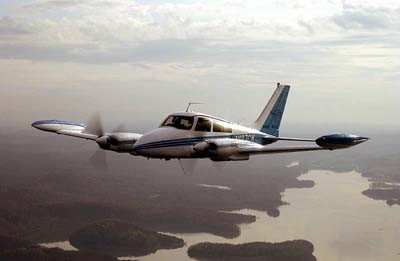Plane Was Released & Operated Despite Knowledge Of
Electrical Problem
 The National Transportation Safety Board determined Wednesday
that a July 2007 aircraft accident in Sanford, FL was caused by a
series of poor decisions, both by corporate flight department
management and by the pilots that flew the accident
aircraft.
The National Transportation Safety Board determined Wednesday
that a July 2007 aircraft accident in Sanford, FL was caused by a
series of poor decisions, both by corporate flight department
management and by the pilots that flew the accident
aircraft.
As ANN reported, a Cessna 310R impacted a
Sanford, FL residential area on July 10, 2007, destroying two
homes. The accident aircraft was part of the fleet operated by
NASCAR's corporate aviation division.
The crash occurred while pilots were performing an emergency
diversion to the Orlando Sanford International Airport after
reporting an in-flight fire. The two pilots on board the airplane
and three people on the ground were killed, four others were
seriously injured.
In its final report, the Board laid blame squarely on the NASCAR
corporate aviation division's decision to allow the accident
airplane to be released for flight with a known and unresolved
electrical system problem, and on the accident pilots' decision to
operate the airplane with full knowledge of the maintenance
discrepancy.
"This accident is especially tragic not only because lives were
lost and people were grievously injured, but because it could have
been so easily avoided," said NTSB Acting Chairman Mark V.
Rosenker.
During its investigation, the NTSB found that the day before the
accident,
another NASCAR pilot flew the accident aircraft and
reported a "burning smell" while in flight. The pilot
turned off the weather radar and manually pulled the associated
circuit breaker, after which the odor dissipated. He recorded this
event in the aircraft's maintenance discrepancy binder and reported
it to senior staff in the NASCAR corporate flight department.

The NTSB states the flight department released the aircraft for
flight, despite being aware of this unresolved issue involving the
aircraft's electrical system. The two pilots, one of whom was
employed by NASCAR and was aware of the unresolved electrical
problem, accepted the aircraft for their planned flight between the
Florida cities of Daytona Beach and Lakeland.
At some point prior to or during the accident flight, it is
likely that one of the pilots reset the circuit breaker that had
been pulled on the previous flight, re-energizing related
components in the electrical system, which likely led to the
inflight fire.
"From the time the plane landed the night before the accident
with a known maintenance issue to the time it was airborne the next
morning, there were numerous opportunities that should have been
taken to stop the chain of events that led to this terrible loss,"
Rosenker said.
 Additionally, in its findings that the NASCAR flight department
had inadequate policies and procedures to prevent an aircraft with
a known maintenance issue to be released for flight, the Board
determined that had a Safety Management System (SMS) been in place,
which would have provided a formal system of risk management and
internal oversight, the accident might have been avoided.
Additionally, in its findings that the NASCAR flight department
had inadequate policies and procedures to prevent an aircraft with
a known maintenance issue to be released for flight, the Board
determined that had a Safety Management System (SMS) been in place,
which would have provided a formal system of risk management and
internal oversight, the accident might have been avoided.
Rosenker remarked that "given how effective SMS would likely
have been in this accident, those corporate flight departments
without one should study the lessons of this accident and ask
themselves how they can justify operating without the substantial
safety improvements such a program provides."
The Board noted that because the accident flight was released
for flight and operated with a known maintenance issue unaddressed,
the aircraft was not in compliance with Federal regulations. In
reference to a missing maintenance document, Rosenker said, "that
the NASCAR flight department had no record of the maintenance form
on which the electrical problem was reported by the pilot on the
previous flight, is frankly, alarming."
As a result of the investigation, the Board issued five
recommendations to the Federal Aviation Administration (FAA). The
NTSB called on the FAA to advise general aviation pilots and
maintenance personnel of how resetting a circuit breaker inflight
without knowledge of what caused the circuit to be tripped, could
create a "potentially hazardous situation," and to require that
information to be included in their initial and biennial training.
The Board further recommended that initial and recurrent training
of maintenance personnel working on general aviation aircraft
include "best practices" regarding the inspection and maintenance
of electrical systems, circuit breakers and wiring.
The Board also recommended that both aircraft manufacturers and
those responsible for postmanufacture modifications improve
guidance or create new guidelines regarding which circuit breakers
pilots should and should not attempt to reset before or during
flight, and that this information be disseminated to airplane
pilots, mechanics and owners.
Lastly, the Board recommended that the FAA develop a safety
alert to encourage all 14 CFR Part 91 business operators to adopt a
Safety Management System that includes sound risk management
practices.
 Airbus Racer Helicopter Demonstrator First Flight Part of Clean Sky 2 Initiative
Airbus Racer Helicopter Demonstrator First Flight Part of Clean Sky 2 Initiative Diamond's Electric DA40 Finds Fans at Dübendorf
Diamond's Electric DA40 Finds Fans at Dübendorf ANN's Daily Aero-Term (04.23.24): Line Up And Wait (LUAW)
ANN's Daily Aero-Term (04.23.24): Line Up And Wait (LUAW) NTSB Final Report: Extra Flugzeugbau GMBH EA300/L
NTSB Final Report: Extra Flugzeugbau GMBH EA300/L Classic Aero-TV: 'Never Give Up' - Advice From Two of FedEx's Female Captains
Classic Aero-TV: 'Never Give Up' - Advice From Two of FedEx's Female Captains




